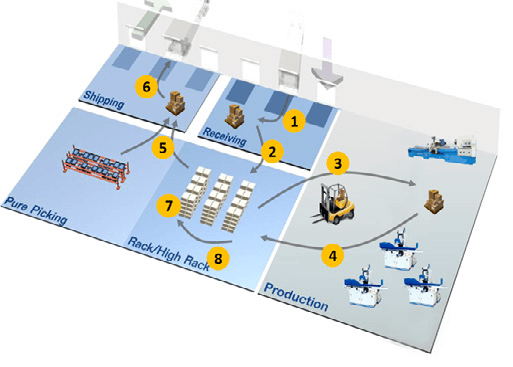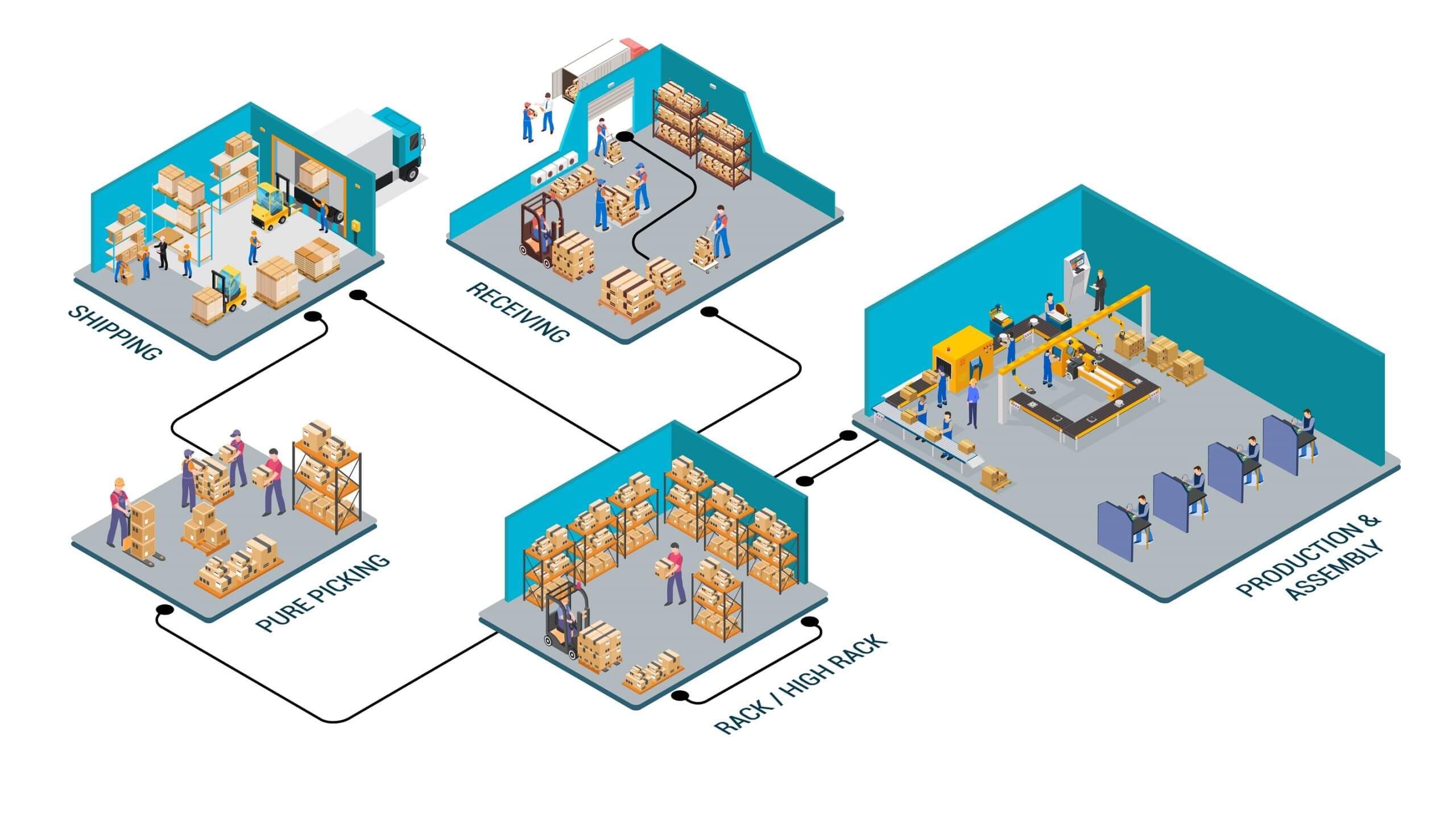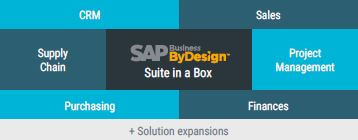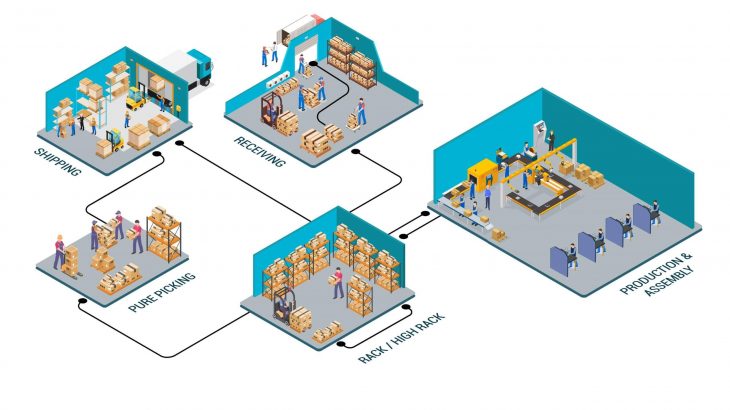1. Introducing warehouse management
Every warehouse is different and should be managed by a unique, customized software solution. Although SAP Business ByDesign is a Cloud ERP Suite with extensive standard processes and functions, you can use it to develop a flexible and dynamic Warehouse Management System to meet the requirements of every company that operates a warehouse.
The solution simplifies operation and boosts productivity. The capabilities and functions of SAP Business ByDesign meet or exceed the vast majority of other dedicated warehouse management systems.
In a study by ibi Research, 62 percent of surveyed online retailers state that they use their merchandise management system to automate processes or reduce manual processes. A total of 49 percent also wanted more transparent processes, while 66 percent introduced merchandise management because of the consistent data inventory it provided. Making the change to software-based automation generally pays dividends even for businesses handling small package numbers per day.
Intralogistics – the flow of goods in the company

From goods receipt 1 , the goods pass through an incoming inspection before moving on to the warehouse system/high-rack storage area 2 . 3 Goods are taken from the warehouse to the production area. 4 The goods and products manufactured are moved to the high-rack storage area/warehouse system. 5 The goods in the warehouse are picked according to the customer orders. 6 Goods issue. The picked customer orders are prepared for shipping and handed over to freight forwarding. 7 and 8 represent the internal stock transfer of products in the warehouse.
Simple operation
The integrated merchandise management (WaWi) of SAP Business ByDesign uses automated data acquisition and workflow compliance to streamline all warehouse tasks. We drastically reduce errors that occur during tasks such as goods receipt, placement in storage, picking, consolidation, and packaging.
SAP Business ByDesign introduces the concept of process validation, which means that employees cannot continue until the current task is correctly completed.
Enhanced productivity
Thanks to this simplicity, items are recorded, placed into storage, picked, bundled, packed, and dispatched with greater speed and accuracy. Warehouse workers can spend more time carrying out necessary tasks instead of wasting time rectifying errors such as misplaced items and incorrectly completed orders. Increased productivity boosts customer satisfaction because customers receive their orders quicker and return them due to errors less frequently.
Return on investment
The business benefits associated with ease of use and enhanced productivity are sufficient to generate a rapid return on investment, so that these functions and processes justify the use of SAP Business ByDesign – in addition to all the other functions of this ERP suite.
2. Getting started
The use of software solutions delivers the most consistent increase in your warehouse efficiency. The software reduces human error and misconduct while at the same time ensuring that each action is validated and completed on time.
First and foremost, your merchandise management system (WMS) administers all operations involved in the receipt of goods and shipping of orders. It assigns the orders by priority, allows you to sort them according to criteria that are important to you, and creates step-by-step instructions to guide your
order pickers. Order priorities can be changed according to specified rules if you wish. This would be virtually impossible using manual sorting procedures. As a result, more orders are shipped and picked, and your team members are informed at all times of their tasks.
Determining the warehouse layout
The warehouse layout is an important aspect when it comes to increasing the efficiency of your warehouse. Many small companies begin with an overflowing room that functions as a warehouse. Employees gradually stack products or components there as they see fit. They find it very difficult to
find these items again later on. What you do next can determine the future of your business. Successfully maintaining warehouse efficiency begins with three simple steps:
- maximizing the warehouse space
- minimizing the physical steps
- Keeping order
Maximizing the warehouse
Your warehouse space is measured in three dimensions. When planning your warehouse layout, you must take account of aisles and racks both at ground level as well as in elevated areas. Good use of the available space can save you a lot of trouble later on. You must also plan for large-scale locations to
store bulk goods and large items as well as small parts containers, wherever necessary.
Minimizing sequences and connections
Every additional step that your employees perform between the items affects your productivity. Each time your employees leave a fingerprint on a product while they move it is counted as a contact. Your warehouse layout should help reduce the number of steps and unnecessary contacts. The movement
of your product and your team members should be minimized so as to expedite the work being carried out and to promote maximum efficiency. Consider the distance that your product travels between your goods receipt and your production sites as well as the goods issue. Next, you need to consider
the average distance that your employees travel between locations while they are picking orders or placing items into storage.Optimize the entire logical sequence.
Keep it clean
One final tip is simply to keep your warehouse clean. Product spillages on the floor and suspended racks present hazards. Time lost due to accidents has a serious impact on the efficiency of the warehouse. In some warehouses, containers are placed at the end of the aisle so that every employee can throw any objects that have fallen down into these containers and can then continue with his or her designated task. At the end of the day, these objects can be returned to their correct location instead of simply being
crammed into the nearest space available, which gets them out of the way but may make it impossible to find them again.
Warehouse locations
Once you have decided how the rack systems will be positioned and how the routes are to be organized, the next step is to create a location diagram. A location concept helps you optimize your workforce by reducing the time required to search for products. It also dramatically reduces accuracy errors when goods and products are placed into storage and picked.
Location diagram
A location diagram describes how you identify the individual locations in your warehouse, for instance, using letters, numbers, the building number, zone, floor, aisle number, section, rack, and site.
If you only have one building or one floor, you can leave these parts out. Using a map of your warehouse floor, you can assign logically coordinated location numbers and then label all these locations on your floor so that your employees know exactly how to find a specific point in your diagram. Once your location diagram is ready, you must assign the products to the location based on characteristics such as size, demand, type, or process. This generally means that some locations are available for bulk goods and others for small goods. Specific locations are often reserved for large-batch items, which are collected directly from the hall again.
Optimizing workflows
The use of assigned storage locations improves warehouse efficiency by optimizing your human resources. Each item in your warehouse will have its place and the WMS keeps an eye on this location for you. If the item is ordered, your WMS informs your employees precisely where it is located on the floor, so all they need to do is go to the correctly labeled aisle, section, rack, and location number to pick it. In addition, items that are currently in demand can always be kept at the optimum picking level so that they can be picked quickly. Items that are frequently ordered together should be grouped close together. This increases the picking density and reduces the number of steps that your employees perform between the locations. It is much more efficient to drive past 10 locations rather than 50 locations.
Tip: If you pick a great deal of products on pallets, it often makes sense to store the heavy
products in the storage area where the order picking path begins.
3. For advanced users
Warehouse layout
If you have been using merchandise management for some time, you can continue to improve warehouse efficiency. Your goal should be to use performance measurements and fine tuning to achieve further improvements. There is always something to be learned from the process and transaction data. The fact that the products also change means that there is constantly scope for improvements on the floor. Use the analysis tools in SAP Business ByDesign for this purpose: The integrated reporting quickly reveals the best and worst sellers in the warehouse.
Measuring and evaluating
Since you now have a functioning warehouse layout, you should focus on the areas where there are still problems. Do your reports indicate an area in the warehouse that is still affected by heavy traffic that is slowing everyone down? Do your employees find one area of the warehouse particularly difficult for picking orders or placing goods into storage? Have you thought of an additional step that could make their work easier? It’s possible that your first layout was not perfect and simply needs some slight adjustments.
Product changes
In all probability, your products will change over time. If this happens, your warehouse layout must be flexible enough to adapt to the products. You will notice that your first layout was too short-sighted and does not allow for changes over time. It can take a whole year to see how your layout functions in every season. Use all the evaluation possibilities in your system and determine whether there are clear indications of a loss of warehouse efficiency during specific weeks or months. How can you address these problems without losing efficiency for the rest of the year?
Warehouse Locations
Random vs. fixed locations
Many warehouses use fixed locations, which means that the products are always stored at the same location or locations. More advanced systems allow you to use random locations because your IT system knows the location where you wish to store a product. You can also have the location selected for you. This information is automatically accessed and then forwarded to your order pickers. This makes it easier to improve the efficiency of placing goods into storage and increase the picking density. It also opens
up various possibilities if your product is subject to seasonal changes.
Additional equipment
Together with a more flexible and detailed location diagram, you have the option of adding physical equipment that builds on your location diagram. These include vertical lift modules that add more locations per square meter and make it easier for your employees to choose from vertical spaces without
using their own ladders or elevators. Carousels operate in a similar way and bring the product to the individual areas. This enables the use of fixed workstations and eliminates steps. Ultimately, pick-to-light systems increase the number of orders that can be picked at any time. They also offer your employees additional step-by-step instructions as to how many products are to be picked or which products are to be placed with which order – and much more besides.
4. Optimizing Work
Optimizing your work is the next step in your warehouse evaluation. Your WMS has many functions that directly influence the efficiency of your warehouse because they relate to your personnel and can increase productivity per employee without making their work more difficult.
For warehouses that contain a product mix with multiple zones and separate as well as simultaneous picking processes, productivity can be increased as follows:
Each employee remains in a zone and does not drive around the entire warehouse. The withdrawals from each zone are then deposited at a collecting station and combined as an order. Naturally, picking within every zone is still controlled by the merchandise management to achieve maximum efficiency.
Digitalizing the pick lists
If picking in a warehouse is not performed using mobile devices, it is generally carried out with the help of a printed pick list. This pick list provides the warehouse personnel with all the relevant information for fulfilling the current order.
In addition to information such as the item name/number, storage bin, and the quantity to be picked, it can also contain other optional information such as the manufacturer, weight, price, or customer data. Even though, picking in warehouses is still often carried out using this method, the majority of systems sold today support picking using mobile devices.
Although the pick list scores highly due to its simplicity and the fact that it gives warehouse personnel a great deal of freedom, the method is usually considered to be obsolete.
The advantages of working with mobile devices like laserscanners are obvious:
- Real-time synchronisation of entered data with your ERP-Software
- More productivity, higher customer satisfaction and reliable inventory thanks to lower error rate
We at all4cloud developed a WMS App called “scan4cloud” with an easy and intuitive interface to manage all logistic tasks on mobile devices like laserscanners, smartphones or tablets.

5. Your Software
Making the right choice
You can choose between a special WMS or a software suite that integrates all merchandise management processes in the ERP (Enterprise Resource Planning). The latter offers many advantages. The use of a specialized software solution that focuses solely on WMS requires a degree of customization on the IT side. You must then link or connect this system with your ERP. Please consider this when choosing your
solution because it will add to the cost. Providers already offer these types of interfaces; simple plug & play is not possible. If, on the other hand, you select an ERP suite that already incorporates merchandise management, these interfaces can be omitted. Another problem is that you must also always update the interfaces whenever new software versions are released.
Adding advanced technology
There is a broad range of advanced tools that can be integrated in your warehouse management system. These days, RFID tags and scanners are tools that can provide comprehensive support for the work carried out by employees in the warehouse. The use of bar codes and their ongoing development
opens up additional dimensions in your warehouse. Other options such as automated storage and retrieval systems, for example, vertical lift modules and carousels, can work hand in hand with your software to solve less work-intensive warehouse tasks.
Improved planning
Once you know how your new system functions, it is time to go one step further and maximize warehouse efficiency by coordinating your movements with your shipping schedule. Your WMS lets you prioritize the order replenishment according to shipping windows. This also includes differentiation of
order shipping with different forwarding agents and their expected collection times. By mastering these capabilities, you will ensure that your customers can enjoy more punctual deliveries.

6. Closing remarks
Many beginners experience an immediate jump in productivity following the successful introduction of a WMS. However, progress does not end here. There are many other functions of your WMS that you can implement with beneficial effect at the end of the process.
If your team has got a grasp of the warehouse layout topics presented in the first half of the guide, then the changeover to additional solutions is a natural next step that will give you added benefits compared with your competitors.










